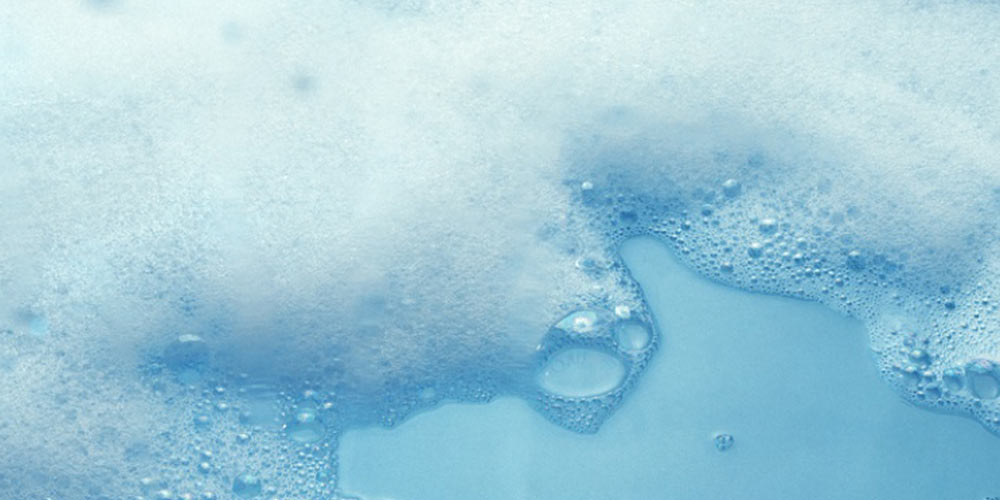Köpük kəsicilərsənaye tətbiqlərində vacibdir. Bir çox sənaye prosesləri, istər mexaniki qarışdırma, istərsə də kimyəvi reaksiya olsun, köpük yaradır. Nəzarət edilməzsə və müalicə olunmazsa, ciddi problemlər yarada bilər.
Köpük su sistemində baloncukları sabitləşdirən səthi aktiv maddələrin olması səbəbindən əmələ gəlir, nəticədə köpük əmələ gəlir. Köpükdən təmizləyicilərin rolu bu səthi aktiv maddələri əvəz etməkdir ki, bu da baloncukların partlamasına və köpüyü azaltmasına səbəb olur.
Köpüklərin əsas növləri hansılardır?
Biofoam və səthi aktiv maddə köpük:
Biofoam mikroorqanizmlər tərəfindən tullantı sularında üzvi maddələrin mübadiləsi və parçalanması zamanı əmələ gəlir. Biofoam çox kiçik yuvarlaq baloncuklardan ibarətdir, çox sabitdir və quru görünür.
Səthi aktiv maddə köpük sabun və yuyucu vasitələr kimi səthi aktiv maddələrin əlavə edilməsi və ya aşındırıcı maddələrin yağlar və ya yağlar və digər kimyəvi maddələrlə reaksiyası nəticəsində yaranır.
Köpükdən təmizləyicilər necə işləyir?
Köpükdən təmizləyicilər mayenin xüsusiyyətlərini dəyişdirərək köpük əmələ gəlməsinin qarşısını alır. Köpükdən təmizləyicilər nazik köpük təbəqəsindəki səthi aktiv maddə molekullarını əvəz edir, bu da monolayın daha az elastik olması və daha çox qırılma ehtimalı deməkdir.
Bir defoamer necə seçilir?
Köpükdən təmizləyicilər ümumiyyətlə silikon əsaslı və silikon əsaslı olmayan köpükdən təmizləyicilərə bölünür. Köpükdən təmizləyicinin seçimi xüsusi tətbiqin tələblərindən və şərtlərindən asılıdır. Silikon əsaslı köpükdən təmizləyicilər geniş pH və temperatur şəraitində effektivdir və ümumiyyətlə sabitlik və səmərəlilik baxımından üstünlük təşkil edir. Qeyri-silikon əsaslı köpük kəsdiricilər əsasən yağ amidləri, metal sabunlar, yağ spirtləri və yağ turşusu efirləri kimi üzvi birləşmələrə əsaslanan köpükdən təmizləyicilərdir. Silikon olmayan sistemlərin üstünlükləri böyük diffuziya əmsalları və güclü köpük qırma qabiliyyətidir; əsas çatışmazlıq, silikondan daha yüksək səth gərginliyinə görə köpük yatırma qabiliyyətinin bir qədər zəif olmasıdır.
Düzgün köpük təmizləyici seçərkən sistemin növü, iş şəraiti (temperatur, pH, təzyiq), kimyəvi uyğunluq və normativ tələblər kimi amillər nəzərə alınmalıdır. Düzgün köpük təmizləyicini seçməklə sənaye köpüklə bağlı problemləri effektiv şəkildə idarə edə və ümumi prosesin səmərəliliyini artıra bilər.
Suyun təmizlənməsində köpükdən təmizləyici əlavə nə vaxt lazımdır?
Suyun təmizlənməsi zamanı adətən suyun qarışdırılması, həll olunmuş qazların buraxılması, yuyucu və digər kimyəvi maddələrin olması kimi köpüklənməyə şərait yaradan şərait olur.
Çirkab suların təmizlənməsi sistemlərində köpük avadanlığı tıxaya bilər, təmizlənmə prosesinin səmərəliliyini azalda bilər və təmizlənmiş suyun keyfiyyətinə təsir göstərə bilər. Köpükdən təmizləyicilərin suya əlavə edilməsi köpük əmələ gəlməsini azalda və ya qarşısını ala bilər ki, bu da emal prosesinin səmərəli şəkildə davam etdirilməsinə kömək edir və təmizlənmiş suyun keyfiyyətini yaxşılaşdırır.
Köpükdən təmizləyicilər və ya köpük əleyhinə vasitələr, arzuolunmaz mərhələlərdə və ya həddindən artıq köpüklənmənin mənfi təsirlərinin qarşısını almaq üçün təmizlənmiş sudan köpüyü idarə edən və lazım olduqda təmizləyən kimyəvi məhsullardır.
Köpükdən təmizləyicilərimiz aşağıdakı sahələrdə istifadə oluna bilər:
● Selüloz və kağız sənayesi
● Su müalicəsi
● Yuyucu toz sənayesi
● Boya və Kaplama sənayesi
● Neft sənayesi
● Və digər sənayelər
| sənayelər | Proseslər | Əsas məhsullar | |
| Su müalicəsi | Dəniz suyunun duzsuzlaşdırılması | LS-312 | |
| Qazan suyunun soyudulması | LS-64A, LS-50 | ||
| Selüloz və kağız istehsalı | Qara içki | Tullantı kağız pulpası | LS-64 |
| Taxta/ Saman/ Qamış pulpası | L61C, L-21A, L-36A, L21B, L31B | ||
| Kağız maşını | Bütün növ kağızlar (karton daxil olmaqla) | LS-61A-3, LK-61N, LS-61A | |
| Bütün növ kağızlar (karton daxil deyil) | LS-64N, LS-64D, LA64R | ||
| Qida | Pivə şüşəsinin təmizlənməsi | L-31A, L-31B, LS-910A | |
| Şəkər çuğunduru | LS-50 | ||
| Çörək mayası | LS-50 | ||
| Şəkər qamışı | L-216 | ||
| Kənd kimyəvi maddələri | Konservləşdirmə | LSX-C64, LS-910A | |
| Gübrə | LS41A, LS41W | ||
| Yuyucu vasitə | Parça yumşaldıcı | LA9186, LX-962, LX-965 | |
| Camaşırxana tozu (çamaşır suyu) | LA671 | ||
| Camaşırxana tozu (hazır məhsullar) | LS30XFG7 | ||
| Qabyuyan maşın tabletləri | LG31XL | ||
| Camaşırxana mayesi | LA9186, LX-962, LX-965 | ||
| sənayelər | Proseslər | |
| Su müalicəsi | Dəniz suyunun duzsuzlaşdırılması | |
| Qazan suyunun soyudulması | ||
| Selüloz və kağız istehsalı | Qara içki | Tullantı kağız pulpası |
| Taxta/ Saman/ Qamış pulpası | ||
| Kağız maşını | Bütün növ kağızlar (karton daxil olmaqla) | |
| Bütün növ kağızlar (karton daxil deyil) | ||
| Qida | Pivə şüşəsinin təmizlənməsi | |
| Şəkər çuğunduru | ||
| Çörək mayası | ||
| Şəkər qamışı | ||
| Kənd kimyəvi maddələri | Konservləşdirmə | |
| Gübrə | ||
| Yuyucu vasitə | Parça yumşaldıcı | |
| Camaşırxana tozu (çamaşır suyu) | ||
| Camaşırxana tozu (hazır məhsullar) | ||
| Qabyuyan maşın tabletləri | ||
| Camaşırxana mayesi | ||
Göndərmə vaxtı: 15 avqust 2024-cü il



